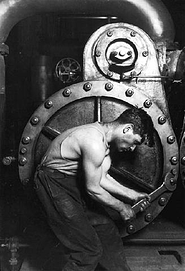7 Facts About Dual Column (Bridge-Type) CNC Machines
Posted by
Mike Williams on Tue, Oct 15, 2013
 Dating back to the time when all machine tools were operated manually and part tolerances were more forgiving, the “C” machine design was the industry standard. When CNC came along, dimensional tolerances tightened and manufacturers demanded faster spindle speeds to deal with harder-to-machine alloys, the inherent performance problems with the “C” design became obvious. We asked Jim Endsley, Product Specialist Machining Centers for Okuma, to explain why the company moved from “C” designs to the current double column or bridge design. Here are the facts Jim shared with us:
Dating back to the time when all machine tools were operated manually and part tolerances were more forgiving, the “C” machine design was the industry standard. When CNC came along, dimensional tolerances tightened and manufacturers demanded faster spindle speeds to deal with harder-to-machine alloys, the inherent performance problems with the “C” design became obvious. We asked Jim Endsley, Product Specialist Machining Centers for Okuma, to explain why the company moved from “C” designs to the current double column or bridge design. Here are the facts Jim shared with us:
- A major problem with the “C” design is that you cannot maintain the amount of rigidity today’s manufacturing demands. Because the working part of the machine tool is hanging from a single upright structure, it’s inevitable that the cutting tool will experience deflection during high-speed or heavy cutting operations. This not only makes it harder to hold tight tolerances, it also initiates vibrations that cause premature wear on many machine components.
- Today, with many parts requiring tolerances in the micron range, even a slight deflection can lead to scrap, rework and missed deliveries. All of which eats away at the manufacturer’s profitability.
- In 1987 Okuma decided that “good enough” wasn’t good enough. Advances in manufacturing technology meant that a better design was both necessary and possible. By using two columns rather than a single column, Okuma is able to greatly increase the rigidity and stability of the machine tool to significantly reduce vibrations, tool deflection and, thereby, hold tighter tolerances while enabling the machine to operate at optimum spindle speeds.
- The dual column design also enables greater control over thermal deformation. In fact laboratory tests confirm that the bridge design is 10 times more thermally stable than a “C” design machine. Here’s why: Because of the dual column design, heat only affects the bridge structure linearly. This means the machine only expands in a straight line, so the changes can be compensated electronically. On the other hand, because of movement in both X- and Y-axes on a single column machine, thermal expansion happens in a cube. This makes it virtually impossible to accurately compensate for these temperature changes.
- The center of the spindle is where all power is applied. The closer it is to the mass of the machine, the more rigid it becomes. On a “C” frame machine tool, the spindle center cannot physically be closer than one-half of the Y-axis travel, because the table moves up against the column. In a dual column design you have complete Y-axis coverage because you move between the columns. This equals a 75% shorter “C loop of force” from the center of the spindle back to the machine mass.
- Although a “C” column design is less costly to make and may reduce the initial purchase price of a CNC machine, a dual column machine tool pays back over time in two important ways. First the dual column design reduces vibration so there is less wear on critical components so the machine tool will perform better over a much longer lifespan. Second, reduced deflection means more accurate cutting, faster spindle speeds and more efficient production.
- Okuma dual column machines are available in a wide variety of sizes and configurations from the affordable Genos series to Millac machines designed to handle the largest jobs. Whatever your application, Okuma has a rigid, reliable dual column CNC machine to suit your needs.
To learn more, contact Gosiger today.